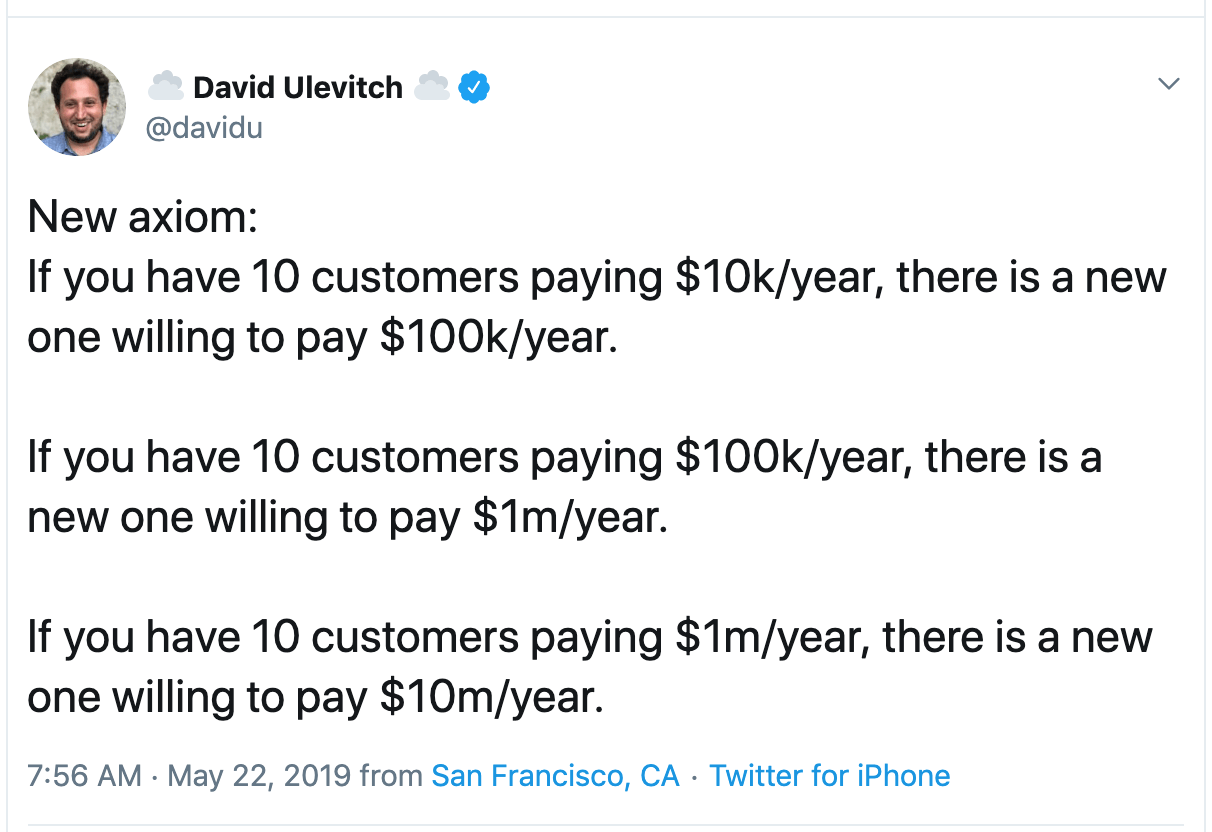For most enterprise startups, discovering which segment of the market to focus on is no trivial feat. Early on in the journey, the hunt is for product-market fit with happy customers, regardless of what segment of the market they fall into. Often times those early customers are smaller businesses that have an easy buying process and shorter time to close. From that initial set of customers it’s all too easy to get comfortable at the lower end of the market without having a pulse on the magnitude of the opportunity, or the confidence, to move up market, even when much bigger customers are desperate for the same solution to the same exact problems that you solve for smaller customers. While staying at the low end of the market may be a deliberate business decision for some, for the rest of you, moving up market is a fantastic way to bring in more dollars per deal without sacrificing deal velocity.
If you have ten customers at a $10k annual contract value (ACV), go find a customer 10x the size. You’re more ready than you think.
Platitudes are rarely trustworthy prescriptions, but one observed dynamic that should get you to at least consider the move up market: After you establish a set of customers at a consistent price point, it’s almost always possible to get a customer at 10x the scale without major product or go-to-market shifts.

This post is based on an earlier tweetstorm from @davidu. https://twitter.com/davidu/status/1131212127878828032
The crux of the 10x customer thesis is that once you’ve won multiple customers paying $10k per year, the odds are that there is a much bigger customer experiencing the same exact pain, just at greater scale. And once enough $10k customers vote with their feet to validate your product, the early adopter $100k customer will have seen enough market validation to pull you to the next order of magnitude on the customer scale ladder.
Making the 10x leap takes less effort than you think and less effort than it took to get in front of the $100k ACV customer.
You may need to satisfy minor feature requests unique to bigger customers, or spend engineering cycles to meet security and compliance requirements, or polish the implementation process. But your core product is what these customers are looking for, and it can carry you to $100k deals primarily with shifts in your sales motion. Plus, the minor adjustments that you make to support the 10x leap would have been necessary sooner or later, and once made, the next leap – from $100k to $1M deals – is even easier.
The jump to $1M may sound like a way bigger feat than the leap from $10k to $100k ACVs, but it’s not. Think of it this way: You’re growing up as a company and at this point you have many dozens of customers buying your product at $10k and now a growing number at the $100k price point, your sales motion is more refined, your product marketing materials are more polished, and your onboarding and implementation efforts are humming. While your product may have only changed incrementally, your company has matured dramatically. As a result, there are generally even less feature or implementation changes that are needed to land the $1M contracts than there was the $100ks.
Once you’ve climbed one rung on the 10x customer ladder, climbing to the next zero is often even easier.
When you earn the right to serve customers at $10k, you open up the $100k door, and once you are serving $100k customers you are knocking at $1M deals. Since it’s often the case that the energy, resources, and time required to win, implement, and support the $1M customer are similar to what is required to make the $100k customer successful, why not focus your sights on where your technology can have the greatest impact for nearly the same organizational caloric spend? And none of this is to suggest that you don’t need to continuously improve your product; of course that has to happen too, but that’s true for all segments of the market you serve.
We consistently see that once a business has won over multiple early adopters paying $100k ACV, even bigger logos are waiting somewhere ready to pay 10x that amount to solve the same exact problem at 10x the scale. Now you just have to go find them! And then why would the fun end at $1M? Good luck!



